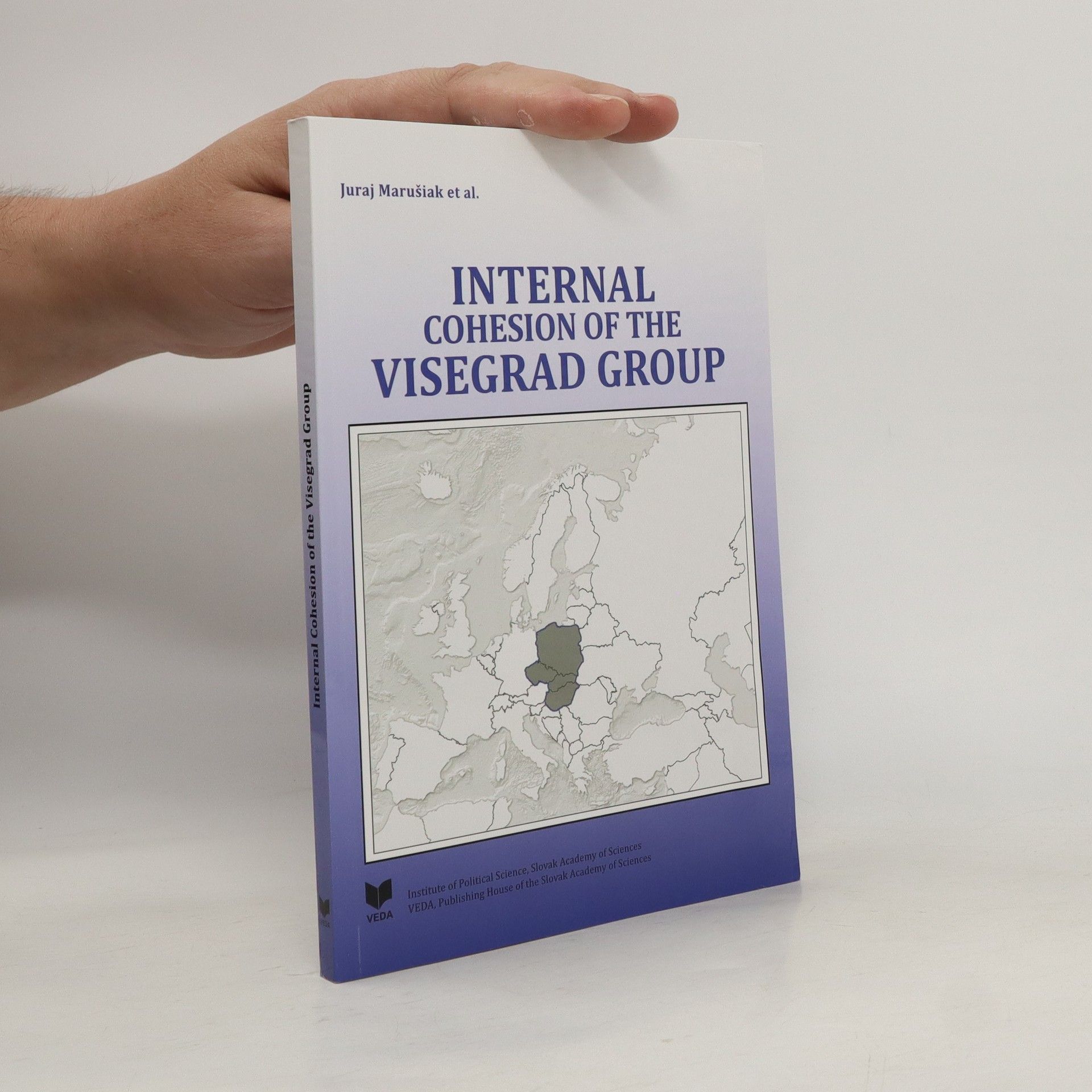Edited by Anna Schneider, with contributions by Elsbeth Court, Imraan Coovadia, Anna Schneider and Dimona Stöckle; and a conversation between Michael Armitage and Don Handa"Paradise Edict" highlights pivotal series by the painter Michael Armitage and positions his body of work within East African painting and sculpture of the 20th century. His wide array of subject matter ranges from the relationship between humans and animals, and political events in his native Kenya, to European landscape traditions in opposition to an East African understanding of nature. With large-format oil paintings on lubugo bark cloth, the British-Kenyan painter joins motifs and artistic traditions from Europe and East Africa in a variety of ways, upsetting visual stereotypes and an excepted balance of power in the process.
Anna Schneider Books







The aim of the publication is to analyze whether there is any Visegrad commonly shared identity or not and what could be the integrative factor of the Visegrad Group. The authors of the publication cover the following topics – historical identities; historical memory; economic cohesion and the level of economic cooperation of the V4 states; the role of the Visegrad topics in the university education and the political culture of the V4 states. The publication shows that the Visegrad cooperation is still based on the interests rather than on the commonly shared identity. However, the citizens of V4 countries already perceive Visegrad as a relevant and meaningful regional group. The fact that Visegrad is considered by the domestic political elites as well as by the political elites abroad as a “brand” or “mark” has a significant contribution to the construction of the regional identity. However, still the motivation of the political leaders to develop the Visegrad cooperation is more pragmatic than based on the awareness of belonging together. The external factors (the EU, gas crisis between Russia and Ukraine in January 2009) and their demand for response still have more efficient impact on the strengthening of V4 cooperation compared to the pressure from inside. V4 could be regarded as more successful project of transition and integration compared to the rest of post-communist states in Central and East Europe both from political and economic perspective. However, there are still substantial differences in the level of economic development, impact of crisis on the V4 states economies, in the living standards, as well as in the political cultures and patterns of political behaviour of citizens. The region of Central and East Europe, including Visegrad, still remains a periphery of the EU, although the EU membership of V4 countries and generally the EU presence in the entire region acts as a factor of stability and contributes to its de-peripheralization. The significant trend for the Visegrad societies is the decreasing level of democracy and growing support of authoritarianism in the region. The de-democratization is not purely the result of sophisticated political programs of certain parts of Visegrad political elites, but it is a result of subconscious practice and pragmatically formulated short-term political targets. However, Visegrad is still a zone of stability, compared to South, South East and East Europe, in part because of the more successful reforms in 1990s and higher efficiency of governance. The peripheralization and marginalization still remains a certain threat for the V4 and Central Europe in general. Such threats are not only the results of the economic or political infrastructure inherited from the Communist past, but their sources consist in some domestic policies implemented since the political changes at the turn of 1980s and 1990s. The improvement of the efficiency of the government’s engagement in the economy is highly recommended. The changes are required in the regional policy as well in order to push the subnational territorial units to formulate their own autonomous approaches to regional development in order to overcome the regional disparities. A significant gap still persists between the “old EU members” and Central European states, including V4, in the financing of the education, science and welfare system. The underdevelopment of these branches could have a negative impact on the future of democracy in the entire region of Central and East Europe.
'Hamid Zénati. All-Over' is a richly illustrated monograph dedicated to the vibrant oeuvre of the artist Hamid Zénati (b. 1944 Constantine, Algeria; d. 2022 Munich, Germany).Travelling between Munich and Algiers, Zénati's artistic practice ranged from painting and textiles to interior and fashion design to photography, always driven by an anarchic impetus to create.This first monograph on the artist features textile works from a five decade-long career and provides insight into the artist's distinct cosmos for the first time.The publication encompasses diverse perspectives by leading thinkers on art and culture.With contributions by Wassila Bedjaoui, Andrea Lissoni, Natasha Marie Llorens, Chus Martínez, Duro Olowu, and Anna Schneider.Published on occasion of the exhibition 'Hamid Zénati. All-Over', 13 Mar - 23 Jul 2023, Haus der Kunst, Munich.This was the first institutional exhibition dedicated to the artist's work.English with a German supplement.
This publication charts the Haus der Kunst München exhibition 'Trace--Formations of Likeness.', drawn exclusively from The Walther Collection.The exhibition explores portrait photography and the tracing of societal transformation across geographic spaces as well as contrasting socio-political and cultural landscapes.Portrait photography has been deployed as a means to shape identity, to advocate for social change, and as a subversive strategy for visibility, often through an intimate investigation of the politics of memory, history, and embodiment.This book encompasses works from the last two hundred years and brings together artists from Africa, the Americas, Europe, and Asia.The juxtaposition of archival, documentary, and vernacular photography offers a global context to reflect on the divergent trajectories of historical and contemporary photography today.Collectively, these works showcase the medium's capacity as both an instrument for empowerment and a formation of the self, as well as its complex uses as a tool for control and subjugation.Features an essay by British curator and cultural historian Mark Sealy.Artists include: anonymous artists and Ai Weiwei, Jane Alexander, Dieter Appelt, Richard Avedon, Martina Bacigalupo, Sammy Baloji, Yto Barrada, Bernd & Hilla Becher, Jodi Bieber, Karl Blossfeldt, Candice Breitz, Cang Xin, Edson Chagas, Kudzanai Chiurai, Mitch Epstein, Em'kal Eyongakpa, and others.
"Chefinspektor Bernhard Krammer steht geschockt in der Wohnung seiner Kollegin Roza Szabo in Innsbruck. In ihrem Wohnzimmer liegt eine männliche Leiche mit einer Tauchermaske. Doch von Roza selbst fehlt jede Spur. Was ist geschehen? Warum hat sie nicht die Kollegen alarmiert, sondern ist wie vom Erdboden verschwunden? Als klar ist, dass Roza das letzte Mal am Walchensee gesehen wurde, bittet Krammer Oberkommissarin Alexa Jahn von der Inspektion Weilheim um Hilfe. Aber Rozas Spur verliert sich am See. Die Ermittlungen geraten zusehends ins Stocken, doch eines wird immer klarer: Jemand ist hinter Roza her. Und wenn Alexa und Krammer sie nicht rechtzeitig aufspüren können, wird sie mit ihrem Leben bezahlen." --
»Lassen Sie sich mit der Grenzfall-Serie auf die dunkle Seite der Alpen entführen. Allerfeinste Krimiunterhaltung!« Romy Fölck Der dritte Band der SPIEGEL-Bestseller-Serie um das deutsch-österreichische Ermittlerteam Alexa Jahn und Bernhard Krammer Ratlos begutachtet Chefinspektor Bernhard Krammer den Fund auf einer Baustelle am Ortsrand von Gnadenwald in Tirol. Zwei präparierte Dachse, in deren Inneren Babykleidung versteckt wurde. Weshalb? Und wer hat die ausgestopften Tiere vergraben? Zur gleichen Zeit erholt sich Oberkommissarin Alexa Jahn in Lenggries von einer Schussverletzung. Bis ein ehemaliger Kollege aus Aschaffenburg mit schlechten Nachrichten vor der Tür steht: In einem alten Fall wurde der Falsche verhaftet. Alexa macht sich Vorwürfe – hat sie damals bei den Ermittlungen etwas übersehen? Während sie den Fall neu aufrollt, kommt Krammer einer Tragödie auf die Spur, deren wahres Ausmaß zunächst niemand ahnt. »Mein Fazit: Besser kann man einen Krimi nicht schreiben.« Deutschlandfunk Kultur, Mike Altwicker »Hochspannend ... genial fügen sich wie bei einem Puzzle alle Teile zusammen.« Süddeutsche Zeitung Band 3 der packenden Krimiserie in der Grenzregion Deutschland – Österreich
Gespenstische Stille liegt über dem Friedhof - Amelies heimlichem Zufluchtsort vor den Bosheiten ihrer Stiefschwester. Sarah hatte sie bestohlen, gedemütigt, verletzt ... Wie weit würde sie noch gehen? Schon spürt Amelie wieder das Stechen im Nacken, wie von eiskalten Augen, die ihr überallhin folgen. Ihr einziger Hoffnungsschimmer ist der Abschlussball mit Ben: Wird er sie wach küssen aus diesem Albtraum? "Ein Jugendthriller vom Feinsten: Hochspannend, berührend und toll geschrieben von der ersten bis zur letzten Zeile". (Nele Neuhaus)
Theaster Gates. Black Chapel
Ausst. Kat. Haus der Kunst München, 2019-2020
- 176 pages
- 7 hours of reading
Theaster Gates confronts German and American legacies of racism through the life of Jesse Owens Guided by the forms of solidarity found within Black communities, American artist Theaster Gates (born 1973) creates visionary installations that transform public spaces into places of artistic and cultural intervention. In Black Chapel , Gates explores recent German and American history through the life of the great African American athlete Jesse Owens. In this expansive exhibition, Gates responds directly to the architecture of Haus der Kunst’s massive Middle Hall, exposing it to a complex and politically charged narrative. Alongside Owens’ complete and fully illustrated record collection being made available for the first time, the exhibition consists of several large pavilions containing sculptures, photographs and documents, as well as huge illuminated rotating panels displaying photographs from the archives of Ebony and Jet , two magazines that contributed significantly to the dissemination of Black culture in the United States. This interplay of sculpture and photography interrogates Black history, spirituality and representation, and recasts them visually.
Sie könnten unterschiedlicher nicht sein und müssen doch gemeinsam einen Mörder jagen – der erste Fall für das deutsch-österreichische Ermittlerteam Alexa Jahn und Bernhard Krammer. Am Brauneck in Lenggries wird an einer Felswand eine leblose Frau entdeckt. Doch was auf den ersten Blick wie ein Kletterunfall aussah, entpuppt sich als grausamer Mord. Dem Oberkörper der Toten wurden Beine aus Stroh angenäht. Kurz darauf tauchen weitere Leichenteile am Achensee in Tirol auf. Stammen sie ebenfalls von der Toten? Doch weshalb sollte der Täter die Leiche auf zwei Länder verteilen?Für die junge und engagierte Oberkommissarin Alexa Jahn, die gerade ihren Dienst bei der Kripo Weilheim angetreten hat, ist es die erste große Ermittlung. Sie könnte jede Unterstützung gebrauchen, doch auf den desillusionierten Kollegen auf österreichischer Seite, Chefinspektor Bernhard Krammer, kann sie nicht zählen.Alexa ist lange auf sich allein gestellt und bekommt es mit einem Täter zu tun, dem sie vielleicht nicht gewachsen ist...
Nova liegt reglos auf dem Boden, ihre Augen starren ins Leere. Was ist in dieser Nacht passiert? Die einzigen Zeugen schweigen und Nova kann ihre Geschichte nicht erzählen, weil sie seither im Koma liegt. Doch Daniel ahnt, dass etwas Schreckliches geschehen sein muss. Zusammen mit Novas bester Freundin Jessi macht er sich auf die gefährliche Suche nach der Wahrheit. „Gutes Thema. Gute Geschichte. Gut erzählt.“ Monika Feth


